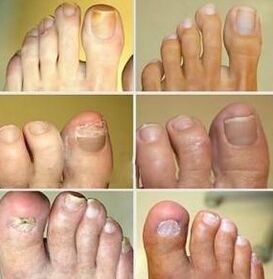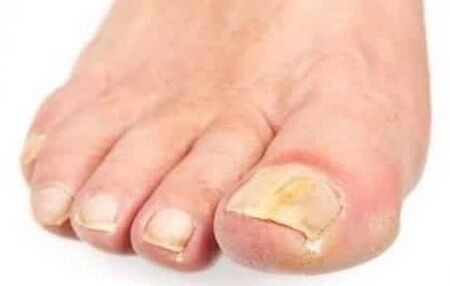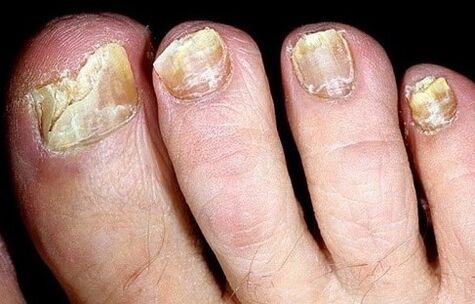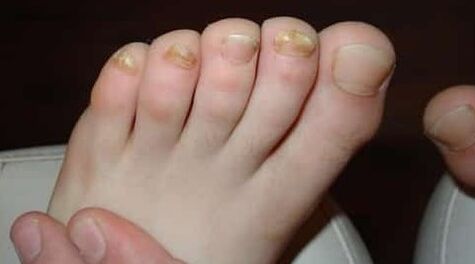Onychomycosis is a pathology that destroys nails.The fungus eats keratin - the construction base of the nail.The infection enters the intracellular space and begins its division.In the advanced stages, the pathology is able to affect the skin of the feet, the internal zone, the heels.

Causes of nail fungus
Contrained with onychomycosis is quite easy.The infection can lurk on the beach, in the public soul, a pool.A high likelihood of capturing a fungus by infected relatives or acquaintances (using a common life).
There are several basic prerequisites that can cause the virus to enter the human body:
- Weak immune system - reduction of protective forces due to infectious or inflammatory diseases;
- Vascular pathologies (vein blocking) disorders of internal organs (diabetes) that lead to blood circulation problems in the lower limbs;
- minor skin damage (abrasions, micro -cracks, calluses, calluses) that have arisen as a result of wearing tight shoes;
- ignoring diapers rash and intensive sweating of the lower limbs;
- Disruption of caution measures - trying foreign shoes, visiting public places without slippers and neglecting the hygiene of the legs.
Nail fungus
Onychomycosis can provoke several types of fungi.For example, dermatophytes appear in the form of clouding of the nail.Along the edges or in the middle of the plate, there is a formation of yellow spots.In addition, longitudinal stripes may be observed in the affected area.
The yeast fungus causes nail deformation.She is very sophisticated and begins to move away from her place, she becomes greyish.Metabolism in damaged cells worsens, and furrows appear on the nail roll.In addition, inflammation, swelling, redness appear on the adjacent epidermis, the disappearance of the nail skin is observed.
Mold bacteria can injure nails if there are already diseases that provoke nail feeding disorders.In this case, there is also a blur of the plate, a change in its color (from light yellow and greenish to brown and even black).
To find out the cause and pathogen of negative changes in the skin and nails, you should contact a specialist.Independent determination of the disease and its treatment without consulting a doctor can be filled with consequences.
Stages of the disease

Mycosis of the nails gradually affects healthy cells.The disease has several stages of development, each of which has its own specific manifestations.
The first stage of onychomycosis (normal) has no bright manifestations.In most cases it continues hidden.The first signs - the nails fade a little, its color changes, micro -cracks and yellow spots are formed in the form of circles or longitudinalities and tuberosis occurs.A novice fungus can be accompanied by itching and burning.It is difficult to recognize the infection properly at the initial stage, as the symptoms are similar to other diseases (psoriasis, liver pathology).
If treatment does not start in time, the disease will go to the next stage - hypertrophic.The nail thickens, dark.There is deformation of the plate, its coronation and destruction.
The sophisticated form of nail disease is manifested by severe thinning of the nails, which leads to its more rejection.The adjacent skin turns blue, an unpleasant odor appears.
Symptoms
Onychomycosis most often affects the nails on the legs, the hands suffer less often.The disease begins with the thumb and the little finger (the outer edge is touched), affecting all the plates smoothly.
Leading symptoms of onychomycosis will help to determine the fungal infection:
- The appearance of strips and spots of whitish or greenish tint under the nails;
- blurring of the plate, change in color (from yellow to dark brown);
- redness and peeling of the skin around the nail;
- the appearance of roughness of the legs and between the toes;
- The formation of mildew on the nails.
Types of fungal diseases of the nails
Onychomycosis is usually classified by the appearance of the affected areas.Because the classification function is what looks like the nail fungus, it differs in three types, depending on the clinical manifestations:
- Atrophic or onholytic - in which the nails are significantly affected, to the degree of nail rejection;
- The hypertrophic species in which it has lost its natural shine, changes its color (whitening or, conversely, darkens) and the structure (more visible) with the appearance of various types of deformities and even destroys at the edges;
- Normotrophic - type, characterized by the largest degree of damage, in which the nail plate does not thicken, remains shiny and smooth, but still externally transforms due to the appearance of spots, stripes and other visible changes in its natural transparency and color.

There is another classification in foreign countries, according to which the nail fungus is divided into species depending on the specific location of the lesion:
- A total in which the whole new plate is covered by a pathogenic process;
- distal - the shape of damage, localizing only on the free edge of the nail protruding above the finger;
- Proximal, in which the edge of the plate appears under the nail roll, is destroyed (against the free edge of the nail!);
- The lateral form of damage affecting the sides of the nails.
What does the pathology look like
Fungal nail diseases in the population have external similarities with other dermatological diseases of the native nature.Depending on the stage of the pathology, the nails begin to look unhealthy because they lose natural shine and transparency.From smooth and uniform, they become thick and deformed and are covered with different colors (often white or dirty yellow).The soft tissues around the keratin layer, destroyed by a parasite, are also involved in inflammatory reactions, swollen and ulcer.
If we look at the picture of nail destruction in the perspective of the dynamics of the disease, then it can be conditionally divided into three consecutive stages:
- In the first stage, there are virtually no signs, except for light stupidity, points or strips of the plate.
- At the so -called pronounced stage, quickly replacing the original, all symptoms of onychomycosis become obvious.
- The advanced stage is the supreme nail degeneration, it can be supplemented by the appearance of an unpleasant odor of decaying tissues.
The reasons for the deformation of the nail
Murl, yeast -like fungi and dermatophytic fungi, cause infectious diseases of the nails (onychomycosis) manifested by similar symptoms.All types of fungus of the toenails of the legs or hands deform the nails, change its transparency, shine, color.Changes in the nail are found not only with onychomycosis, but also in injuries, chronic paraniya (inflammation of the nail roll), psoriasis, manual execution, dermatitis.Before drawing a fungal infection, you should consider all the possible options.
Fungus symptoms
There are different classifications of nail fungus, depending on the type and manifestation, they can have completely different signs and symptoms, so it is very important to determine it (psoriasis, eczema, homeless lichen and dermatophyte).Surface onychomycosis of the fingers occurs almost immediately after the infection, consider the symptoms and signs of the fungus on the toenails and hands:
- Bold plate;
- Fragile, crumbly or torn nails not only near the edge, but all over the surface;
- Distorted forms, flaky structure;
- The initial stage is the loss of shine and elasticity;
- If the nail is blackened (not at the expense when a person regularly works with coloring compositions or mechanical parts);
- Nails collapse under the skin;
- Dysbacteriosis begins, probably a general decline in immunity, strength, drowsiness;
- Itching between the toes and on the foot is especially pronounced in the child;
- The nail test is a very common phenomenon and almost the last stage before the complete loss of the nail, which is called onycholisis.You can feel pain in your fingers and find a slightly unpleasant odor;
- The skin becomes dry, cracks, a rash appears, probably even the appearance of blood or suckon;
- White or a yellow circle of mildew under the nail, depending on the variety of fungi, it can be bright, dull, with outlined edges and muddy construction.

Before you begin active action, it is necessary to minimize the negative impact of the external environment in order to eliminateThe reasons why the fungus appearedUnder the toenails:
- The warm and humid environment is ideal for the growth of various microorganisms, try to dry the shoes all the time after walking, wear socks only from natural materials that provide normal thermal and air exchange;
- The fungus of the feet often occurs due to poor immunity, you can simply step on the floor with the bare leg and take the infection, take vitamins to avoid this;
- Frequent nail extension can become one of the causes of onychomycosis, limit the procedure to 1 session in six months;
- The most complicated is the sympathy - it is a fungus caused by active disputes.They penetrate the hollows between the nails and fingers, can be in a sleep stage for a while and then grow sharply.Most often, they are infected in public areas (pools, showers, solariums), during the work of other people's shoes, etc.
Common species of mycosis of braking
There are many ways to get an infection with a fungus of the legs, but this is only possible with direct contact with the pathogen.Most often, this happens during the use of other people's shoes or in violation of personal hygiene rules.The skin fungus of the feet is usually manifested by the destruction of the dermis, which is reflected in the form of peeling.The lesions of the epidermis in this case are caused by the fact that the infection penetrates the deep layers of the skin, destroying its structure.
Modern medicine identifies the following options for fungal damage to the legs, each of which differs in its symptoms and treatment options:
- Intodal mycosis is the most common form in the form of the disease.The symptom is usually localized between 3 and 4 fingers, rarely between 4 and 5, looks like a crack covered with a white film.It is possible to separate a certain amount of fluid, peeling at borders, and the appearance of signs of diaper rash.The signs of interdigital leg fungus can be accompanied by weak itching.Such a fungus of the toes initially may appear completely without symptoms, but in the future there is a significant change in the structure of the skin.
- The fungus of the squamous hyperkeratotic can be distinguished from other species through severe peeling and keratinization that affect the epidermis.It is characteristic of people suffering from various types of dermatitis, mainly atopic.This is another type of disease that can clearly see what mushrooms are on the feet.The main symptom of the disease is the appearance of erythema, a painful pink knot in the affected area that has clear boundaries.It is accompanied by weak itching, cracks in the legs, dryness, pain, jaundice and damage to the nail plates.Onychomycosis, usually accompanying this type of fungus, leads to nail stratification;
- Vesicular fungus is one of the most common types of infections that affects the skin of the feet.The disease was named for the formation of vesicles - bubbles of liquid content, at the place where erosion is formed, which is dangerous for infection.The main signs that fungal vesiculosis differs: the appearance of blisters up to 1 centimeter in diameter, as well as weak itching;
- Deleted fungi.At the initial stage there is a slight peeling of the legs of the legs, as well as the appearance of small cracks affecting externally only the upper layer of the epidermis.
- The fungus is a brew, whose infection is found in medical practice in only 8% of patients infected with mycosis.It is located mainly on the sole and arch of the foot, manifests itself in the form of bubbles, gradually merging into one, after which its precipice occurs, followed by the formation of extensive erosion.The danger of a fungus of this type is the ability to bind bacterial infection, as pathogenic microorganisms easily penetrate the resulting wound;
- Intermining mycosis is not only independent independently, but also as accompanied by a squamous form of the fungus of the legs.It manifests itself between the toes of the steps, characterized by severe itching and burning, a rash of the diapers and the appearance of erosion;
- Onychomycosis is another common option for damage, which is a fungus of the toenails.It usually develops from the free edge of the nails, the initial stage is characterized by the appearance of yellow spots, after which the disease progresses with relaxation and complete leave of the nail.Often accompanies other forms of fungal lesions;
- Candidal fungus, also called yeast erosion, which is localized in the interdigital space.In this case, the fungus of the legs looks like the concentration of inflamed swollen areas of the skin, which can be surrounded by low -shape pustules.

















